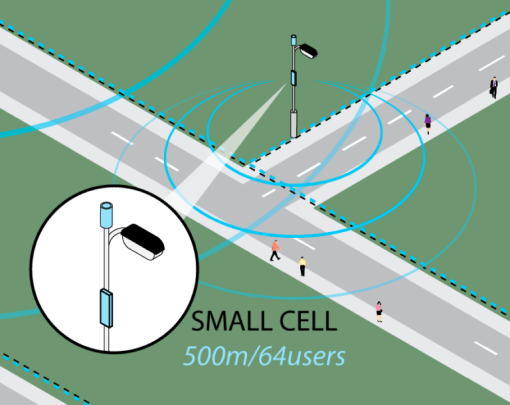Number of Cell Towers and Small Cells in the United States in 2023

The Wireless Infrastructure Association recently issued a white paper that included their estimates of the number of macrocells, cell towers, and small cells in the US at the end of 2022. In the white paper the WIA and the drafter of the report iGR (a widely respected and reputable industry analyst) provide the following estimates:
1. 142,100 Cell Towers
2. 209,470 Macrocell Sites
3. 678,700 Macrocell Sectors
4. 452,200 Small Cell Nodes
5. 747,400 Indoor Small Cell and DAS Nodes
Over the last 25 years, I have acquired tower and small cell data from hundreds of sources including publicly available databases like the FCC ASR data, municipal data, and private sources like tower company data and Steel in the Air’s extensive number of leads and clients. Based upon our data and research, we don’t necessarily agree with their numbers.
Number of Cell Towers in the US
To the WIA, a cell tower is defined as a tower that is used by a cellular provider that was primarily constructed for the cellular provider. By their own definition, it excludes towers that were built exclusively for government, municipal, public safety, or other users besides cellular. It also excludes towers under 50’ because those are considered small cells (even though there are many macrocell towers under 50’ – just ask people in California). Admittedly, it is difficult to determine the number of cell towers. Our estimate is closer to 175,000 cell towers in the US, although again this is a question of definition so either our numbers or WIA’s could be easily supported.
Number of Macrocell Sites in the US
We aren’t sure where they came up with 209,500 macrocells. A 2022 CTIA report estimated that there are 417,000 macrocells of which 69,000 were built between 2018 and 2020 (don’t get me started on how patently absurd that latter claim is – it looks like they counted AT&T FirstNet as separate cell sites).
Our estimates of macrocells are between 250,000 to 275,000 cell sites in the US. Higher than WIA, but significantly lower than CTIA. Oddly, the WIA includes fixed wireless deployments as macrocells – which we don’t. Presumably, their number should be even higher.
Number of Outdoor Small Cells in the US
There are 452,200 outdoor small cells. WIA defines an outdoor small cell as a “node,” noting that there can be multiple nodes deployed at each small cell pole. Have 4G on a pole counts as one node. Add low band 5G, and that’s another node. Add CBRS and yes, another node. Add millimeter-wave, and bam – you have 4 “small cells.” It’s not that we disagree with their number (since we don’t have the visibility to the number of separate “nodes” deployed across the US).
This number is not representative of the number of separate outdoor small cell poles/locations across the US. I understand counting separate installations by AT&T and T-Mobile on the same pole as separate small cells, but not counting each of their separate technologies or nodes by each carrier on each installation as individual small cells.
The concern I have is that people in the industry or outside the industry that don’t understand the nuance of node vs small cell will assume that there are 452,200 separate outdoor locations or poles with small cells. Perhaps this explains WIA’s previous claims that there would be 800,000 small cells in operation by 2026 – this number is used extensively as support for any regulatory or legislative hearings or initiatives by the FCC. They didn’t mean separate small cell locations, they mean separate “nodes.” However, that was not explained anywhere that we saw.
We previously surveyed 70+ cities and counties and our estimate at the time was closer to 100,000 separate small cells. I would estimate the number of outdoor small cells (locations) closer to 150,000 but it wouldn’t surprise me to find out it that it was as high as 200,000.
Number of Indoor Small Cells in the US
We don’t have an independent estimate for the number of indoor small cell nodes, but for the reasons expressed above under Outdoor Small Cells, I suspect that this number may overreport the actual number of individual indoor small cells – although it may not be as much as with outdoor small cells. However, it is easier to physically deploy separate nodes at different locations indoors than outdoors.
Why Does it Matter?
Ultimately, reports like these serve to help support WIA lobbying initiatives and encourage activity and investment in the wireless industry. In looking at the following conclusion of the document, one must wonder whether this was the starting premise or truly the conclusion after the analysis.
Wireless infrastructure, which comprises cellular towers, small cells, networks, and the associated services and hardware, supports critical services that keep the nation’s consumers and businesses connected, driving the country’s economic prosperity and social well-being.
While we don’t dispute this “conclusion,” we believe that the inflated numbers (especially on outdoor small cells) will be used by the industry and lobbyists to validate previous state legislation or FCC Orders on small cells. They will also be used in slide decks and confidential information memorandums advocating investment in the wireless industry.
As Mike Dano reports in Light Reading-
“The WIA's findings are also important to ongoing work among regulators, equipment vendors, entrepreneurs and others to make it easier and cheaper for network operators to build more 5G transmission sites.”
And that’s exactly why it matters. Starting with misleading or unclear data can yield false expectations, misguided legislation, misplaced investment, and erroneous conclusions. Especially on the outdoor small cell front.











